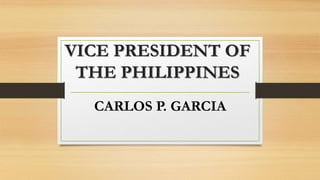
Carlos P. Garcia: Eighth President of the Philippines
- 1. VICE PRESIDENT OF THE PHILIPPINES CARLOS P. GARCIA
- 2. Carlos P. Garcia • Carlos Polestico Garcia KR (Tagalog: [ˈkaɾlɔs pɔlɛsˈtɪkɔ gaɾˈsɪa]; November 4, 1896 – June 14, 1971) was a Filipino teacher, poet, orator, lawyer, public official, political economist, guerrilla and Commonwealth military leader who was the eighth president of the Philippines. A lawyer by profession, Garcia entered politics when he became representative of Bohol’s 3rd district in the House of Representatives. He then served as a senator from 1945 to 1953. In 1953 he was the running mate of Ramon Magsaysay in the 1953 presidential election. He then served as vice president from 1953 to 1957. After the death of Magsaysay in March 1957, he succeeded to the presidency. He won a full term in the 1957 presidential election. He ran for a second full term as president in the 1961 presidential election and was defeated by Vice President Diosdado Macapagal.
- 3. Early life and education • Garcia was born in Talibon, Bohol, Philippines on November 4, 1896, to Policronio Garcia and Ambrosia Polestico, who were both natives of Bangued, Abra. • Garcia grew up with politics, with his father serving as a municipal mayor for four terms. He acquired his primary education in his native town Talibon, then took his secondary education in Cebu Provincial High School, now Abellana National School, both at the top of his class. Initially, he pursued his college education at Silliman University in Dumaguete, Negros Oriental, and later studied at the Philippine Law School, then the College of Law of National University, where he earned his law degree in 1923 and later, where he was awarded the honorary degree Doctor of Humanities, Honoris Causa from the National University in 1961. He also received an honorary doctorate degree from Tokyo University in Japan.[2] He was among the top ten law students in the 1923 bar examination.
- 4. • Rather than practicing law right away, he worked as a teacher for two years at Bohol Provincial High School. He became famous for his poetry in Bohol, where he earned the nickname "Prince of Visayan Poets" and the "Bard from Bohol."
- 5. Political career • Garcia entered politics in 1925, scoring an impressive victory to become representative of the third district of Bohol. He was elected for another term in 1928 and served until 1931. He was elected governor of Bohol in 1933, but served only until 1941 when he successfully ran for Senate, but he was unable to serve due to the Japanese occupation of the Philippines during World War II. He assumed the office when Congress re-convened in 1945 after Allied liberation and the end of the war. When he resumed duties as senator after the war, he was chosen Senate majority floor leader.[4] The press consistently voted him as one of the most outstanding senators. Simultaneously, he occupied a position in the Nacionalista Party.
- 6. World War II • Garcia refused to cooperate with the Japanese during the war. He did not surrender when he was placed on the wanted list with a price on his head. He instead and took part in the guerilla activities and served as adviser in the free government organized in Bohol.
- 7. Vice-presidency (1953–1957) • Garcia was the running mate of Ramon Magsaysay in the 1953 presidential election in which both men won. He was appointed secretary of foreign affairs by President Magsaysay, and for four years served concurrently as vice-president. • As secretary of foreign affairs, he opened formal reparation negotiations in an effort to end the nine-year technical state of war between Japan and the Philippines, leading to an agreement in April 1954. During the Geneva Conference of 1954 on Korean unification and other Asian problems, Garcia, as chairman of the Philippine delegation, attacked communist promises in Asia and defended the U.S. policy in the Far East. In a speech on May 7, 1954–the day that the Viet Minh defeated French forces at the Battle of Diên Biên Phu in Vietnam– Garcia repeated the Philippine stand for nationalism and opposition to Communism
- 8. • Garcia acted as chairman of the eight-nation Southeast Asian Security Conference held in Manila in September 1954, which led to the development of the Southeast Asia Treaty Organization (SEATO).
- 9. Presidency (1957–1961) • Accession • At the time of President Magsaysay's sudden death on March 17, 1957, Garcia was heading the Philippine delegation to the SEATO conference then being held at Canberra, Australia.[6] Having been immediately notified of the tragedy, Vice President Garcia enplaned back for Manila. Upon his arrival, he directly reported to Malacañang Palace to assume the duties of president. Chief Justice Ricardo Paras of the Supreme Court administered the oath of office, which took place at 5:56 PM on March 18, 1957. President Garcia's first actions were to declare a period of national mourning and to preside over the burial ceremonies for Magsaysay.
- 10. 1957 presidential election • President Garcia won a full term as president with a landslide win in the national elections of November 12, 1957. Garcia, the Nacionalista candidate, garnered around 2.07 million votes or 41% of the total votes counted, defeating his closest rival, Jose Y. Yulo of the Liberal Party. His running mate, House Speaker Jose B. Laurel Jr., lost to Pampanga representative Diosdado P. Macapagal. This was the first time in Philippine electoral history where a president was elected by a plurality rather than a majority, and in which the winning presidential and vice-presidential candidates came from different parties.